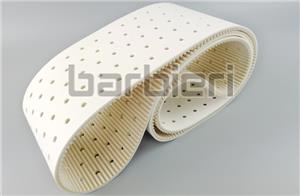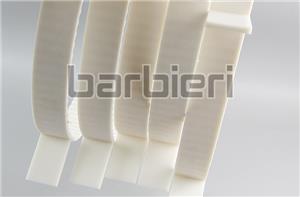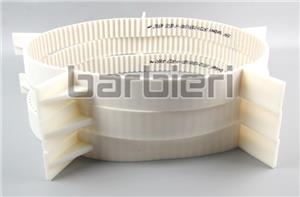-
1.What is the difference between PU timing belt and rubber belt?
[Polyurethane timing belt VS rubber belt]
1. What is the difference between PU timing belt and rubber?
The Barbary timing belt is made of polyurethane (PU), with high hardness and strong tensile force of the seamless belt. The size of the connecting belt can be freely selected and the selection is flexible. The rubber belt has better temperature resistance.
The PU belt can choose to use steel wire core or Kevlar core; the rubber belt has glass fiber core. Because the tension structure inside is different, the PU timing belt has strong tension and is suitable for high-strength transportation; the rubber timing belt has good flexibility and is suitable for high-speed operation.
At present, Barbary’s main products are made of polyurethane, which can be customized according to your needs.
2. What is the material hardness of the PU timing belt?
95°A. -
2.What model does Barbieri Polyurethane Synchronization have? What is the difference between metric and imperial gears? What is the difference in the use of different colors of the same product?
【Model of Polyurethane Synchronous Belt】
1. What types of timing belts do you have?
BARBIERI's polyurethane synchronization comes with the following series:
Inch gear series, metric gear series, arc gear series, parabolic gear series.
Inch gear series: XL, L, H, XH;
Metric gear series: T5, T10, T20, AT3, AT5, AT10, AT20;
Arc tooth series: HTD3M, HTD5M, HTD8M, HTD14M;
Flat top arc tooth: STD3M, STD5M, STD8M, STD14M;
Concave top parabolic teeth: RPP5M, RPP8M, RPP14M.
2. What is the difference between metric and imperial gears?
The main difference between metric and imperial gears is the pitch. For places where ISO and international standardization units are implemented, the use of metric gears is more conducive to the unity of equipment design and technical parameters of related components.
3. What kind of machine is suitable for the synchronous belt with arc teeth?
Arc teeth are more suitable for use on high-speed equipment.
4. What is the general use of T-type synchronous belts?
Mainly depends on the design, some positions are used to ensure that the synchronous wheel retaining ring does not touch the product, or the limitation of the design position.
5. If I don't want a steel wire groove on the side of the belt, what width can I choose for AT10?
You can choose 17. 25mm, 32mm, 38mm, 50mm, 100mm, these can be customized, small order quantity and price need to communicate with the sales manager.
6. What is the standard width of the ATK series?
The standard is 100. This is because there is a tooth-shaped guide block in the middle, so when we are forming, we first form 100 wide.
[Color of polyurethane timing belt]
1. What are the colors of the bottom belt of the synchronous belt?
Generally speaking, it is white or black. The dental tape (TT5) is blue, yellow, and green.
2. What is the difference in the use of different colors of the same product?
There is no difference in the use of different colors. -
3.What are the standard tolerances and precision tolerances of Barbieri polyurethane timing belts?
[Tolerance of polyurethane timing belt]
1. What is the standard tolerance of the width and thickness of the timing belt?
The width is ±0.5mm, and the thickness is ±0.2mm.
The width and thickness of the synchronous belt of straight edge machine and beveling machine ±0.5mm, the width and thickness of synchronous belt of double-sided machine ±0.1mm
2. What is the width and thickness tolerance accuracy of your processing timing belt?
The accuracy of the width and thickness of Barbary's processed polyurethane timing belt is ±0.1mm tolerance zone.
3. Can the width tolerance of the synchronous belt be plus or minus 0.01mm?
Our Barbary's polyurethane timing belt width tolerance limit processing standard is ±0.1mm, and ±0.01mm is equivalent to zero tolerance.
4. What is the tooth pitch tolerance of the timing belt?
±0.5mm per meter.
5. What is the function of tooth pitch tolerance?
Tooth pitch tolerance is the most important dimensional parameter of the timing belt, and it is the parameter to ensure the accuracy of the belt transmission length.
6. What is the length tolerance of your open synchronous belt?
±5% of the total belt length.
7. What is the straightness standard of your company's belt?
3mm/2 meters.
8. What effect does the belt straightness have on the use of the equipment?
Using a belt with good straightness, the equipment can avoid deviation from left to right when conveying items. In addition, products with high straightness will have relatively low belt wear and machine noise. -
4.How many types of interfaces does synchronization have? What is the difference between a splice belt and a seamless belt? Can the splice belt be replaced with a seamless belt?
[Polyurethane connecting timing belt VS polyurethane seamless timing belt]
1. How many types of interfaces are available for synchronization?
Barbary synchronous belts are equipped with two endless belts: no interface (seamless synchronous belt)/with interface (connected to synchronous belt) (pin connected to synchronous belt)
2. What is the difference between a splice belt and a seamless belt?
The connection is equipped with a hot melt interface or pin connection. The wire is not continuous, so the position of the interface is worse than the belt body; while the seamless steel wire is continuous, so there is no weak point of tension; seamless is more resistant grind.
3. How to connect the white polyurethane open timing belt?
Use a tooth plate/tooth block to fix the two ends of the belt separately, or fix the two ends of the belt to a tooth block.
5. Will the wire break?
Do you want to ask about seamless timing belt?
The seamless synchronous belt is made of a high-strength spiral steel wire core and a high-wear-resistant thermoplastic polyurethane material. Due to the use of the endless seamless steel wire belt core, there is no connection and welding position, which greatly enhances the strength and tensile strength of the belt, so it is very suitable for power transmission and high-load transportation.
It depends on what machine it is applied to. If it is not necessary, it is recommended to use a connecting synchronous belt, which can not only reduce the cost of use, but also achieve good results.
6. The original equipment of our glass factory is connected to the synchronous belt. Can I change the seamless synchronous belt now?
Under normal circumstances, the tensile force of a double-sided mill will be relatively large, and it will be seamless in many cases, but the tensile strength may not be very good. After using for a period of time, even if the belt is intact, the surface rubber is worn out. The original standard cannot be reached. The price of the connecting belt will be lower than that of the seamless belt. -
5.What coverings can be added to the polyurethane timing belt? What special processing does the synchronous belt have?
[Processing method of polyurethane timing belt]
1. What kinds of coverings can be added to the polyurethane timing belt?
Ordinary red rubber, natural red rubber, white rubber, black natural rubber, white PU, transparent PU, gray straight pattern, grass green pattern, 3.7P8DN dark green pattern, blue cloth pattern, fish bone pattern, sponge, APL, etc.
2. What special processing does the synchronous belt have?
Adding stoppers, milling teeth, perforating, surface rubber digging windows, grinding windows, horizontal grooves, V-shaped grooves, half-side rubber, adding guide bars, etc., and special processing according to customer requirements. -
6.What causes the tooth skipping of the synchronous belt? Why does the timing belt always run off? Why do the teeth of the timing belt wear so fast? Why does the timing belt degummed and turned yellow during storage? How to deal with it?
[About the installation of polyurethane timing belt]
1. Is there an easy way to install your timing belt?
No, our timing belt cannot be pried close to the pulley like a rubber V-belt. It must be installed in accordance with our installation instructions.
2. What causes tooth skipping?
The tooth profile or pitch of the timing belt and the pulley do not match.
3. Why is the timing belt always running off track?
It is possible that the pulleys are not aligned during installation.
It may also be the problem of belt straightness. Using a belt with good straightness, the equipment can avoid deviation from left to right when conveying items. In addition, products with high straightness will have relatively low belt wear and machine noise.
4. Why do the teeth of the timing belt wear so fast?
The belt is pedaled too tightly, the pulley pitch is not standard, and the equipment is overloaded.
5. Why does your timing belt make louder noises when it is running?
There may be a problem with the pulley and belt matching.
[About storage of polyurethane timing belt]
1. Why does the timing belt degummed and turned yellow during storage?
Due to the nature of the material itself, polyurethane timing belts will experience long storage time, yellowing due to improper storage, degumming, and aging. These are normal phenomena, not the quality of the belt itself.
2. How to deal with the timing belt degumming?
If the storage time is short and degumming occurs, it should be sent back to check whether it is a quality problem of our company's products, and the glue can be refilled.
If the storage time is long and automatic degumming occurs, it is recommended to scrap it and do it again. Because under this condition, the bottom belt is also aging to an unusable level at the same time.
3. Some of our straps are degummed. Could you please re-glue them for us? What is the cost?
Our company has to look at the specific date of manufacture of the strap, as well as the degree of wear of the strap. The cost is also determined by the specific size.
4. What should I do if the timing belt turns yellow?
If the belt is not stored in a standard sealed package and it is oxidized, it will turn yellow to a certain extent. At this time, it should be based on the belt itself. If it does not affect the material properties of the belt itself, it can be used. -
7.What are the main materials of Barbieri's synchronous wheels? What other materials can the sync wheel be made of? What accuracy can be achieved with concentricity?
1. What are the main materials of Barbieri's synchronous wheels?
The materials of Barbieri synchronous wheels are aluminum alloy and 45#.
2. What other materials can be made of the synchronous wheel?
Copper can also be made, but this is not a commonly used material. If it is made, the business terms will be quite different.
3. What accuracy can you achieve with the concentricity of the synchronization wheel?
The accuracy can be 0.05mm, the normal accuracy is 0.1mm -
8.What are the types of retaining rings for synchronous wheels? How many ways are there to fix the retaining ring? What are the forms of surface treatment? How many colors are available for surface treatment?
1. What are the types of retaining rings for your company's synchronous wheels?
Punching 45# retaining ring, laser 45# retaining ring, laser aluminum alloy retaining ring.
2. How many ways are there to fix the retaining ring?
Extrusion, welding, screw fixation, structural locking.
3. What are the forms of surface treatment of synchronous wheels?
45# steel has blackening, nickel plating, and zinc plating; aluminum alloy has oxidation.
4. How many colors are available for the surface treatment of aluminum alloy?
Available in white, metallic, blue, and black.
5. What color does 45# galvanized have?
White zinc, color zinc and blue zinc.
- What is the difference between PU timing belt and rubber belt?
- What model does Barbieri Polyurethane Synchronization have? What is the difference between metric and imperial gears? What is the difference in the use of different colors of the same product?
- What are the standard tolerances and precision tolerances of Barbieri polyurethane timing belts?
- How many types of interfaces does synchronization have? What is the difference between a splice belt and a seamless belt? Can the splice belt be replaced with a seamless belt?
- What coverings can be added to the polyurethane timing belt? What special processing does the synchronous belt have?
- What causes the tooth skipping of the synchronous belt? Why does the timing belt always run off? Why do the teeth of the timing belt wear so fast? Why does the timing belt degummed and turned yellow during storage? How to deal with it?
- What are the main materials of Barbieri's synchronous wheels? What other materials can the sync wheel be made of? What accuracy can be achieved with concentricity?
- What are the types of retaining rings for synchronous wheels? How many ways are there to fix the retaining ring? What are the forms of surface treatment? How many colors are available for surface treatment?
- Polyurethane Timing Belt
- Annular Timing Belt
- Open-end Timing Belts
- AT-series Timing Belts
- T-series Timing Belts
- STD-series Timing Belts
- HTD-series Timing Belts
- RPP-series Timing Belts
- TT5-series Timing Belts
- Imperial Series Timing Belt
- Supported Polyurethane Flat Belt Series
- Double Sided Timing Belt
- ATN-series Timing Belts
- Timing Belt With Backing
- Timing Belt With Fabric
- Timing Belt Punching
- Polyurethane Self-tracking Timing Belt
- Polyurethane Belt With Profile
- Special Processing Timing Belt




